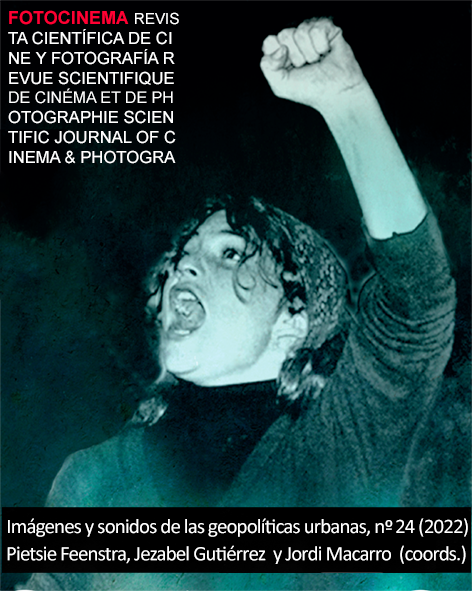Representations of the flâneur in Anglo-Saxon urban landscaping cinema (1980 – 2005)
DOI:
https://doi.org/10.24310/Fotocinema.2022.vi24.14164Keywords:
Flâneur, Urbanism, Landscaping, Cinema and City, Experimental Films, Documentary FilmsAbstract
This work aims to update the attributes of the Benjaminian flâneur, taking into account the aesthetic experience of contemporary urbanism, which is characterised by the consequences of neoliberal urbanistic policies implemented between the second half of the XX century and the present day. The deregulatory measures enforced on urban land have led to the expansion of gentrified downtown lanscapes in every global city and a suburbial periphery occupied by the middle class’ residences. By analizying a compilation of landscaping films produced between 1980 and 2005 - works that fit somewhere between the categories of experimental cinema and documentary film - this article intends to define what effects this new type of architecture has in the psyche of the new “neoliberal” flâneur, the essence of which cannot possibly be the same as that Walter Benjamin defined when he rescued the archetype from Baudelaire about a century ago, since the capitalist invasion of social gathering centres has nowadays reached entirely new heights.
Downloads
Metrics
Publication Facts
Reviewer profiles N/A
Author statements
Indexed in
-
—
- Academic society
- N/A
- Publisher
- Universidad de Málaga
References
Benjamin, W. (2005). Libro de los pasajes. Madrid: Ediciones Akal.
Berman M. (mayo de 2013). Emerging from the ruins. Conferencia llevada a cabo en el City College de Nueva York, Estados Unidos. Recuperado de https://www.dissentmagazine.org/article/emerging-from-the-ruins
Boyer, M. C. (2004). Ciudades en venta: la comercialización de la historia en el South Street Seaport. En M. Sorkin (Ed.), Variaciones sobre un parque temático. La nueva ciudad americana y el fin del espacio público (pp. 181-204). Barcelona: Gustavo Gili.
Coates, J. (2017). Key figure of mobility: the flâneur. Revista Social Anthropology, 25 (1), 28-41. Recuperado de https://eprints.whiterose.ac.uk/145212/3/4.%20The%20flaneur_COMPLETE.pdf DOI: 10.1111/1469-8676.12381
Debord, G. (1955). Introducción a una crítica de la geografía urbana. Amano. Recuperado de http://serbal.pntic.mec.es/cmunoz11/debord3.pdf
De Solà Morales, I. (2002). Territorios. Barcelona: Gustavo Gili.
Durán Segura, L. (2018). Miradas urbanas sobre el espacio público. Revista Reflexiones. 90 (2), 137-144. Recuperado de https://revistas.ucr.ac.cr/index.php/reflexiones/article/view/1466
Freud, S. (1955). The 'Uncanny'. En The standard edition of the complete psychological works of Sigmund Freud. V. XVII (pp. 210-252). Londres: Hogarth Press.
Houellebecq, M. (2000). El mundo como supermercado. Barcelona: Anagrama.
Jameson, F. (1991). Ensayos sobre el posmodernismo. Buenos Aires: Imago Mundi.
Ocampo Failla, P. (2004). Periferia. La heterotopia del no lugar. Revista Urbano, 7 (9), 92-95. Recuperado de http://revistas.ubiobio.cl/index.php/RU/article/view/547
Ritzer G. (1992). La Mcdonaldización de la sociedad. Un análisis de la racionalización en la vida cotidiana. Barcelona: Ariel.
Villarmea Álvarez, I. (2015) Documenting cityscapes. Urban change in contemporary non-fiction film. Columbia University: Wallflower Press.
Downloads
Published
How to Cite
Issue
Section
License
All contents published in Fotocinema Revista científica de cine y fotografía are protected under the Creative Commons Attribution-NonCommercial-ShareAlike 4.0 International (CC BY-NC-SA 4.0) license. All about this license is available in the following link: <http://creativecommons.org/licenses/by-nc-sa/4.0>
Users can copy, use, redistribute, share and exhibit publicly as long as:
- The original source and authorship of the material are cited (Journal, Publisher and URL of the work).
- It is not used for comercial purposes.
- The existence of the license and its especifications are mentioned.
There are two sets of authors’ rights: moral and property rights. Moral rights are perpetual prerogatives, unrenounceable, not-transferable, unalienable, imprescriptible and inembargable. According to authors’ rights legislation, Fotocinema. Revista científica de cine y fotografía recognizes and respects authors moral rights, as well as the ownership of property rights, which will be transferred to University of Malaga in open access. The property rights are referred to the benefits that are gained by the use or the dissemination of works. Fotocinema. Revista científica de cine y fotografía is published in an open access form and it is exclusively licenced by any means for doing or authorising distribution, dissemination, reproduction, , adaptation, translation or arrangement of works.
Authors are responsable for obtaining the necessary permission to use copyrighted images.














13.png)



